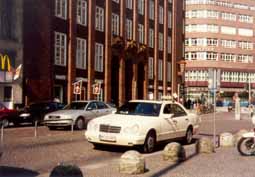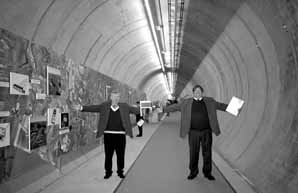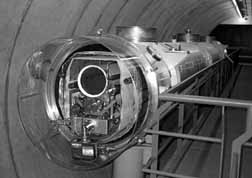 |
|
Tesla by Taxi by Judy Jackson
"We're from Chicago."
Chicago and Hamburg have a lot in common. They're both flat, they're both on the water, they're both cold in March. Also in both Hamburg and Chicago, almost everyone speaks English.
No, we came to visit DESY, the high-energy physics lab in Hamburg.
Scientists at DESY held a colloquium to announce a proposal for a new particle accelerator called TESLA that they would like to build here in Hamburg. More than a thousand scientists came from all over the world to hear about the TESLA Technical Design Report.
Five big books with the results of nearly ten years of work and study for a new accelerator: what science it would do, what technology it would use, how big it would be, how much it would cost, where it might be built, who would use it, who would build itÍ.
"TeV Energy Superconducting Linear Accelerator." The "TeV" part stands for "trillion electron volts." It means that TESLA would have an energy of a million million electron volts--that's a lot.
Well, TESLA would be a linear collider, a particle accelerator creating trillions of very high-energy collisions between electrons and antimatter particles called positrons. The high energy of the collisions would give particle physicists a powerful new tool for exploring the most fundamental questions about matter, space and timeˇalmost like recreating the Big Bang, but in miniature. Scientists have theories about matter, about why particles have mass, about how gravity fits into the picture, about dark matter and dark energy in the universeÍ Accelerators like TESLA give them a way to find out if their theories are true. TESLA would also create an powerful and precise new kind of x-ray laser called a free electron laser. The X-FEL would give structural biologists and materials scientists an unprecedented atomic-scale, three-dimensional imaging technology.
TESLA started out as the vision of a great accelerator physicist and a great man, Bjorn Wiik. He was the director of DESY from (date tk) until he died in 1999. He had the idea for TESLA, and he inspired an international collaboration of scientists centered at DESY to bring it to life.
TESLA would stretch out in a thirty-three kilometer line, in a long tunnel from ten to thirty meters underground. If it were built here in Hamburg, the electron accelerator would start at DESY, and reach out toward the northwest, through the countryside toward the town of Ellerhoop. At the other end, the positron accelerator would start in Westerhorn in the district of Pinneberg. The electrons and positron would collide underneath the outskirts of Ellerhoop.
Yes, it would be completely safe. The collisions would have no effect on the soil or the water or the environment. The people who live above the tunnel would not know that anything was happening beneath them.
Scientists are always searching for the most advanced and most powerful tools for their research. Particle physicists need very high-energy accelerators; materials scientists and biologists need advanced imaging tools. If they built TESLA, scientists would come.
There are other accelerators. Back home in Chicago, we have the Tevatron, the most powerful particle accelerator in the world. There's a new one under construction--
At CERN, yes. Now, the world's physicists are thinking about what and where the next accelerator will be. TESLA is one proposal, but it's not the only idea. Other collaborations in other countries have their own proposals. In the U.S., we also have ideas for new machines. No one knows yet exactly what or where the world's next accelerator will be. We do know that any new accelerator will have to be a truly international project. One thing that makes TESLA very interesting to scientists is that it uses superconducting technology to accelerate particles.
Superconducting materials conduct electricity without losing energy. Superconducting accelerating structures can create high particle collision rates, high-power particle beams and small beam sizesˇall good things in a particle accelerator. And superconductors save electricity. One of the great achievements of the TESLA collaboration is to develop superconducting accelerating structures powerful enough and cheap enough to form the basis for a realistic superconducting linear collider. It was no easy job!
The whole thingˇthe linear collider, the free-electron laser facility, and a particle physics detector to look at the particle collisionsˇwould cost about 3.9 billion Euros, or 7.6 billion Deutschmarks over ten years.
It would have to be an international project. DESY is making the assumption that half of the costs would come from the federal government of Germany, and the other half would come from foreign countries.
That is a question that the German people and the German government will have to answer, as well as the governments of other nations. It's a big investment, and you're right, there are many other needs. But you could think about it this way: investing in basic science, the kind that happens at a particle accelerator, can sometimes help solve problems like disease and pollution. For example, the XFEL could allow biologists to watch a virus in the act if infecting a cell. That might lead to breakthroughs in preventing infections. We don't know exactly where the discoveries from an accelerator like TESLA will lead. We do know from experience that the more fundamental the knowledge we gain, the more profound will be its consequences.
Scientists from other countries are very interested in TESLA. At the TESLA Colloquium this weekend, the organizers expected about two or three hundred scientists. In the end, (number tk) came, 40 percent from outside Germany. That's one measure of worldwide interest. Everyone recognizes that the Design Reportˇthe science, the technology, the planning and the communicationˇis a remarkable achievement. There was a strong sense of excitement at the colloquium.
Next, the Wissenschaftsrat, the German Scientific Council, will study the design report and the TESLA project for about a year, when they will make a report to the German federal government. Then, the government will decide on the TESLA Project. DESY estimates that, if the project is approved, it will take about eight years to build.
I think that, as a citizen of Hamburg, you should be very proud of your high-energy physics laboratory, and proud of the people of DESYˇfor their accomplishments, for their absolute excellence in science and technology, and for the energy and spirit they bring to the world community of physicists in planning for the future. The TESLA Project is a perfect example.
Why not take a tour and see for yourself?
They would be happy to see you. DESY loves company!
Auf viedersehen.
|
| last modified 3/16/2001 by C. Hebert email Fermilab |
FRLsDFx9eyfrPXgV
 Hamburg, Saturday, March 24. The TESLA Colloquium and the Test Facility tour at DESY, the Deutches Elektronen-Synkrotron, have ended. A few hours of chilly afternoon daylight remain, enough for a quick sightseeing tour. We take a cab from our hotel near DESY in the near-west Hamburg suburbs and ask the driver, a tall young woman with a sweet smileˇand, it turns out, a lively curiosityˇto take us to the Rathaus, the 18th century neo-Renaissance City Hall at the city center. She asks where we're from.
Hamburg, Saturday, March 24. The TESLA Colloquium and the Test Facility tour at DESY, the Deutches Elektronen-Synkrotron, have ended. A few hours of chilly afternoon daylight remain, enough for a quick sightseeing tour. We take a cab from our hotel near DESY in the near-west Hamburg suburbs and ask the driver, a tall young woman with a sweet smileˇand, it turns out, a lively curiosityˇto take us to the Rathaus, the 18th century neo-Renaissance City Hall at the city center. She asks where we're from.

